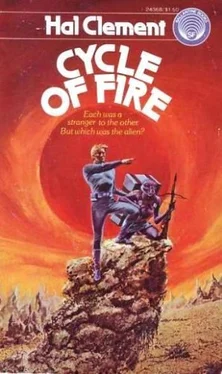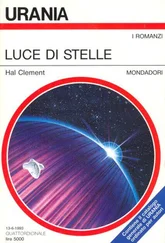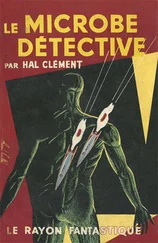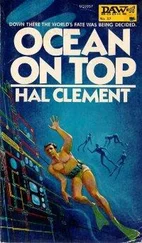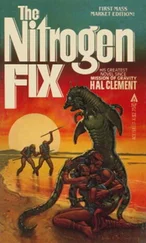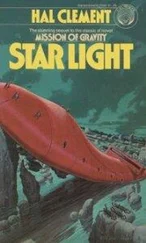No reason to use the weapon developed, however. Eventually the two stood with the jungle behind them and only a few hundred yards of relatively open ground between them and the first buildings. They stopped where they were and examined them carefully.
Still nothing moved and no suspicious sound reached even Dar’s ears. After several minutes of waiting Kruger started forward once more. He did not look back or ask whether Dar was following, but the pilot stayed with him — with thoughts quite indescribable to a human being seething in his head. If anything was going to happen — if his illogical trust of Nils Kruger was unjustified — now was the time it would happen. He still held his bow but, to his credit, it was not aimed anywhere near Kruger.
The ground underfoot changed suddenly to firm pavement, on which Dar’s claws scraped faintly. Like the buildings, the pavement was made of lava blocks carefully squared and fitted. The buildings were not as high as Kruger had guessed from a distance — that is, not as high in absolute units; they did have the three or four stories that the window arrangement had suggested. Each story, however, averaged about five feet in height.
The buildings themselves hardly constituted houses, at least from Kruger’s point of view. They were much too open for that. Not only was more than half the wall space taken up by unglazed windows, but the ground level seemed to consist mostly of doorways. They did have solid roofs and would presumably be some protection against rain, but there their usability as dwelling places seemed to stop.
The doors themselves were a little odd, if they could be called doors. Kruger, after examining the outside of half a dozen buildings, found himself unable to decide whether the lower stories could be said to have a bell-shaped door every few feet, or that the outer walls consisted of oddly shaped pillars. The latter seemed a slightly better way to put it, since calling an opening four feet wide at the bottom, three and a half feet high, and shaped like a probability curve a “door” seemed stretching the usual meaning of the word.
Both travelers realized one thing rather quickly; each had been telling the truth in denying any connection with the city. The ceilings were too low for human beings, and while Dar could have moved about inside any one chamber without trouble, the doors had certainly not been built for his species either. This realization almost made Dar uncock his weapon — but not quite.
Kruger wanted to investigate the interiors of some of the buildings, but at Dar’s suggestion decided to get a better idea of the entire city first. They moved on down the street on which they had found themselves when they first reached pavement.
This led toward the sea but did not appear to reach it. The plan of the city was sufficiently complicated so that no one street appeared to go entirely across it. Kruger kept on toward the sea, believing that the largest and most informative buildings should be at the waterfront.
He was partly right. The city did extend down to the sea, with more imposing structures appearing as they proceeded. However, the largest of these were not at the waterfront. They were well out in the harbor.
It took some little time for Kruger to digest this fact. Dar was even more startled; he had been willing to accept evidence that Kruger had no connection with the builders of this city, but he had been perfectly sure that the builders themselves were fire-lovers — the location as well as the structural materials used seemed to prove that. Such a hypothesis, however, did not square too well with buildings seemingly built under water with complete disregard of the change of environment. Dar knew little about fire, but even he was aware of this inconsistency. He drew a little closer to his large friend.
“I guess this place must be older than I thought,” Kruger remarked slowly. “It must have taken a long time to drop the coast or raise the water level enough to submerge those buildings. It couldn’t have been a sudden shock or the place wouldn’t be standing.”
“What are we going to do, then?”
“Well, I’d still like to go through one of these buildings. There’s no telling what we’ll find that might prove useful, and anyway I’m curious.”
Dar found that he was curious too, in spite of the weight of eight centuries of tradition, and he followed Kruger without objection as the boy walked over to a nearby building, dropped to his hands and knees, and crawled through one of the openings in the wall. Inside, Dar was able to stand up with reasonable head clearance; he walked around freely while Kruger remained on his knees for some time looking about him.
The open structure of the outer wall had the advantage of letting in plenty of light, but it also meant that they had seen most of what there was to see from outside. In this case that was very little. A room, or hallway, about fifteen feet wide ran the full length of the building parallel to the street; it was completely devoid of furnishings of any sort. The inner wall of this passage possessed doors similar in size and shape to those leading from the street but not nearly so many of them. Kruger chose one at random and crawled through. Dar followed.
This room was also long and narrow, but its longer dimension was away from the street rather than parallel to it; the door through which they had entered was in one end. It was much smaller than the outer hall. At the far end was a dais raised about a foot from the floor. At four points, seemingly at random, on the floor itself were dome-shaped structures about two feet high and eighteen inches in diameter with fluted sides that made them look like inverted jelly-molds. They were made of some light-colored stone; Kruger was just barely able to slide one along the floor when he got between it and the wall and used his legs. Their purpose was certainly not obvious. Other furniture seemed easier to explain; there was a rectangular metal affair with sliding drawers and a mirror-smooth surface made of highly polished obsidian set into one of the side walls. The mirror, if that was its intended function, was about the same size and shape as the doors.
The drawers of the bureau, or filing cabinet, or whatever it was were fastened by simple latches. The top one was empty. The second was nearly full of metal objects, about half of which had no obvious function, while the others might very well have been drawing instruments. There was a pair of dividers, a straight edge marked off as a scale, a semicircular protractor divided into eighteen major parts by deep engraving in the metal, and several tools apparently for both cutting and engraving. One of these, a scalpel-like affair with a double-edged blade and a handle about three inches long, he pointed out to Dar with the suggestion that he take it along; he had been using Kruger’s knife on his meat ever since he had discovered the advantages of a metal blade. The handle was not of a shape to fit his hand very closely, but neither was that of Kruger’s knife, and this at least was nearer to the proper size.
Further examination of the room disclosed a small pipe emerging from one wall, with what appeared to be a burner nozzle at the tip. Kruger deduced a gas lighting fixture, with the corollary that the builders of the city possessed eyes.
The dais at the rear of the room contained two shallow, bowl-shaped depressions a little under four feet in diameter which might have been flower pots or bathtubs for all Kruger could guess. Approaching it, however, he seemed to feel an increase in temperature. Since he was always soaked with perspiration anyway, he wasn’t sure at first, but when he touched the wall he jerked his hand away again with a startled exclamation; the surface was burning hot.
Dar preserved himself from hysterics only by a major exercise of will. He wanted nothing to do with sources of heat, artificial or not, and he withdrew to the door while Kruger finished his investigations alone. These took some time, for just as he had decided that there was nothing more to see, his eye caught a metal plate set flush with the floor. This was only about an inch square, and almost featureless, but careful examination disclosed a pair of tiny perforations near each of its sides.
Читать дальше
